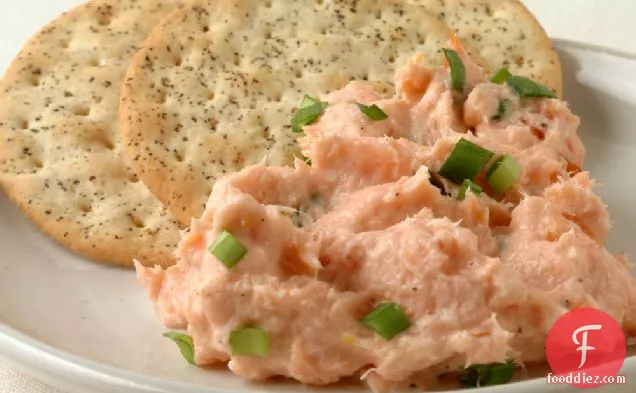Smoked Salmon-Cardamom Spread

Smoked Salmon-Cardamom Spread is It works best as a condiment, and is done in around 45 minutes. A mixture of lemon rind, chives, hot-smoked salmon fillet, and a handful of other ingredients are all it takes to make this recipe so flavorful. Smoked Salmon Spread, Smoked Salmon Spread, and Smoked Salmon Spread are very similar to this recipe.
Instructions
1
Place half of salmon, sour cream, rind, juice, cardamom, and pepper in a food processor. Process until smooth.
Ingredients you will need![Sour Cream]() Sour Cream
Sour Cream![Cardamom]() Cardamom
Cardamom![Pepper]() Pepper
Pepper![Salmon]() Salmon
Salmon![Juice]() Juice
Juice![Beef]() Beef
Beef
Equipment you will use![Food Processor]() Food Processor
Food Processor
3
Coarsely chop remaining salmon, and fold into salmon mixture. Gently fold in 1/4 cup chives. Cover and chill.
Ingredients you will need![Chives]() Chives
Chives![Salmon]() Salmon
Salmon
5
How to Hot-Smoke a Salmon: Besides fresh fish at the seafood counter, keep an eye out for smoked salmon, either hot-smoked (kippered) or cold-smoked (lox). I use hot-smoked salmon in the winter for pizzas and other savory dishes. Lox is more delicate and doesn't hold up to cooking, but we serve it with breakfast toast and with appetizers in the afternoon.
Ingredients you will need![Smoked Salmon]() Smoked Salmon
Smoked Salmon![Seafood]() Seafood
Seafood![Salmon]() Salmon
Salmon![Toast]() Toast
Toast![Fish]() Fish
Fish
6
Although commercially smoked fish is readily available, you can also prepare your own on the grill with wood chips available in small bags from most markets. I prefer alder wood if it is available. Use this smoked salmon in the recipes here, or add it to pasta, pizza, or a main-course salad. -KD
Ingredients you will need![Smoked Salmon]() Smoked Salmon
Smoked Salmon![Smoked Fish]() Smoked Fish
Smoked Fish![French Fries]() French Fries
French Fries![Pasta]() Pasta
Pasta
Equipment you will use![Grill]() Grill
Grill
Ingredients
Recommended wine: Chardonnay, Pinot Noir, Sauvignon Blanc
Salmon works really well with Chardonnay, Pinot Noir, and Sauvignon Blanc. To decide on white or red, you should consider your seasoning and sauces. Chardonnay is a great friend to buttery, creamy dishes, while sauvignon blanc can complement herb or citrus-centric dishes. A light-bodied, low-tannin red such as the pinot noir goes great with broiled or grilled salmon. The Foley Estate Winery Sta. Rita Hills Chardonnay with a 4.3 out of 5 star rating seems like a good match. It costs about 27 dollars per bottle.

Foley Estate Winery Sta. Rita Hills Chardonnay
Rancho Santa Rosa Vineyard was originally conceived as individual micro-vineyards delineated into 59 unique blocks based upon soil, exposure, elevation, grade, rootstock and clone. Rancho Santa Rosa produces remarkably rich and silky wines.DifficultyHard
Ready In45 m.
Servings20
Health Score9
Related recipes
Garlicky Green Beans
Cheesy Vegetable Frittata
Oven Sour Cream Omelet
Quick Creamy Asparagus Soup
Magazine

Your Inner Chef with Taylor Swift's Top 3 Recipes from Her Beloved NYC Hangout

20 Mouthwatering Recipes You Need to Try Today!

Master the Art of Making Perfect Pancakes with This Foolproof Recipe

The Science Behind Red Wine: Its Surprising Health Benefits and Potential Risks

12 Wine Cocktails for a Sophisticated Twist

Sip, Swirl, and Celebrate: Toasting to National Wine Day on May 25th

National Drink Wine Day on February 18

Celebrating Souffle Day with Delectable Delights

Indulge in the Delightful Flavor of Oyster Soup on Its Special Day!

Celebrating World Nutella Day

25 Best Dinner Ideas For Winter

18 winter Holiday Treats for Kids

16 Comforting Winter Recipes Perfect for Cold Days

14 Best Christmas Party Food Ideas

12 Great Ideas for Your Winter Holiday Menu

Traditional Caribbean foods

Traditional British Foods

Traditional Barbecue foods

Traditional American Foods

Seasonal December Foods and How to Cook Them

10 Foods that Relieve Constipation Naturally

Discover the Nutritional Superpowers of a Brown Food Diet

Art of Chimichurri: A Mouthwatering Recipe

Uncover 10 Most Loved Recipes of 2023

Start the New Year Right with These Delicious Gluten-Free Recipes

Discover the Secrets to Perfectly Popped Popcorn at Home

Homemade Hummus Tips and Tricks for the Perfect Blend

10 Irresistible Beef Recipes That Will Make Your Taste Buds Dance

A Step-by-Step Guide to Perfectly Cooked Corn










